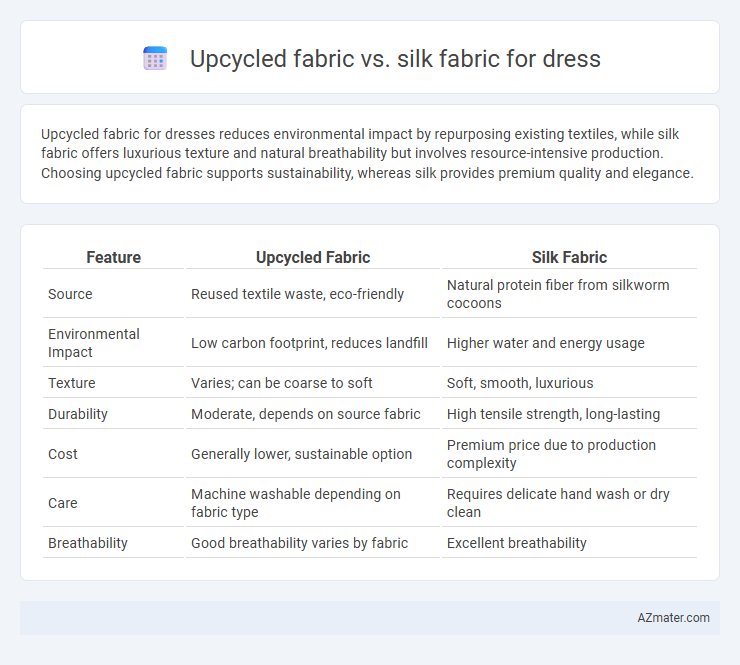Upcycled fabric for dresses reduces environmental impact by repurposing existing textiles, while silk fabric offers luxurious texture and natural breathability but involves resource-intensive production. Choosing upcycled fabric supports sustainability, whereas silk provides premium quality and elegance.
Table of Comparison
| Feature | Upcycled Fabric | Silk Fabric |
|---|---|---|
| Source | Reused textile waste, eco-friendly | Natural protein fiber from silkworm cocoons |
| Environmental Impact | Low carbon footprint, reduces landfill | Higher water and energy usage |
| Texture | Varies; can be coarse to soft | Soft, smooth, luxurious |
| Durability | Moderate, depends on source fabric | High tensile strength, long-lasting |
| Cost | Generally lower, sustainable option | Premium price due to production complexity |
| Care | Machine washable depending on fabric type | Requires delicate hand wash or dry clean |
| Breathability | Good breathability varies by fabric | Excellent breathability |
Introduction to Upcycled and Silk Fabrics
Upcycled fabric is created by transforming pre-existing textiles into new, unique materials, reducing waste and promoting sustainable fashion. Silk fabric, derived from the fibers produced by silkworms, is renowned for its luxurious texture, natural sheen, and breathability. Dresses made from upcycled fabric emphasize eco-conscious design, while silk offers timeless elegance and comfort.
Environmental Impact: Upcycled vs Silk Fabric
Upcycled fabric significantly reduces textile waste and lowers carbon emissions compared to silk fabric, which involves resource-intensive sericulture with high water and land use. The production of silk generates a larger environmental footprint due to the energy needed to cultivate mulberry trees and harvest silkworms. Choosing upcycled fabric for dresses promotes circular economy principles and minimizes ecological degradation linked to raw material extraction.
Texture and Comfort Comparison
Upcycled fabric often features unique textures derived from diverse original materials, offering a slightly coarse or varied feel that enhances garment individuality but may lack the smoothness of silk. Silk fabric provides a luxurious, naturally smooth texture with a soft, breathable quality that promotes exceptional comfort against the skin. While silk excels in temperature regulation and softness, upcycled fabrics contribute eco-friendly versatility, often requiring additional processing to match silk's comfort level in dressmaking.
Aesthetic Appeal and Visual Differences
Upcycled fabric offers a unique, textured aesthetic with varied patterns and colors that emphasize sustainability and individuality, while silk fabric provides a smooth, lustrous appearance known for its elegance and luxurious sheen. The visual differences are apparent as upcycled materials often display irregularities and eco-conscious charm, contrasting with silk's consistent, glossy finish and fluid drape. Choosing between upcycled and silk fabrics for dresses influences both the garment's environmental impact and its stylistic expression.
Cost Efficiency and Affordability
Upcycled fabric offers superior cost efficiency compared to silk fabric, as it utilizes reclaimed materials, reducing production expenses and minimizing environmental impact. Silk fabric, while luxurious and durable, involves higher costs due to labor-intensive harvesting and processing methods. Choosing upcycled fabric for dresses provides an affordable, sustainable alternative without compromising on quality or style.
Durability and Lifespan of Dresses
Upcycled fabric offers enhanced durability due to its reinforced fibers and sustainable processing methods, often extending the lifespan of dresses compared to conventional materials. Silk fabric, while luxurious and soft, typically requires delicate care and is prone to wear and tear, which can shorten dress longevity if frequently used. Choosing upcycled fabric for dresses results in longer-lasting garments ideal for eco-conscious consumers seeking durability without compromising style.
Ethical Considerations in Fabric Choice
Upcycled fabric reduces textile waste by repurposing existing materials, significantly lowering the environmental impact compared to conventional silk production, which involves intensive water use and contributes to habitat disruption through sericulture. Ethical considerations favor upcycled fabric due to its support for circular fashion and decreased resource consumption, while silk raises concerns about animal welfare and labor conditions in silk farming. Choosing upcycled fabric aligns with sustainability goals and promotes responsible consumption, making it an ethically preferable option for eco-conscious dressmakers.
Maintenance and Care Requirements
Upcycled fabric requires gentle washing and air drying to maintain its texture and avoid fading, often benefiting from cold water cycles and minimal detergent use. Silk fabric demands meticulous care, including hand washing with mild detergent or dry cleaning, and must be kept away from direct sunlight to prevent fabric weakening and discoloration. Both fabrics benefit from low-heat ironing or steaming, but silk's delicate fibers necessitate the use of a pressing cloth to avoid damage.
Versatility in Fashion Design
Upcycled fabric offers significant versatility in fashion design due to its unique textures and patterns derived from repurposed materials, enabling designers to create one-of-a-kind, sustainable dresses. Silk fabric, known for its smooth texture and natural sheen, provides elegance and fluidity, making it ideal for formal and high-end dress designs with a luxurious appearance. Combining upcycled fabric with silk can enhance design flexibility, merging sustainability with sophistication in dressmaking.
Final Verdict: Choosing the Right Fabric for Dresses
Upcycled fabric offers an eco-friendly and sustainable choice for dresses, reducing textile waste while providing unique textures and patterns. Silk fabric, favored for its luxurious feel, natural sheen, and breathability, excels in elegance and comfort but comes with a higher environmental and cost footprint. The final verdict depends on prioritizing sustainability and individuality with upcycled fabric or opting for classic luxury and softness through silk.

Infographic: Upcycled fabric vs Silk fabric for Dress
 azmater.com
azmater.com